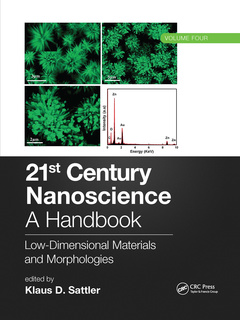21st Century Nanoscience – A Handbook Low-Dimensional Materials and Morphologies (Volume Four) 21st Century Nanoscience Series
Coordonnateur : Sattler Klaus D.

21st Century Nanoscience - A Handbook: Low-Dimensional Materials and Morphologies (Volume 4) will be the most comprehensive, up-to-date large reference work for the field of nanoscience. Handbook of Nanophysics by the same editor published in the fall of 2010 and was embraced as the first comprehensive reference to consider both fundamental and applied aspects of nanophysics. This follow-up project has been conceived as a necessary expansion and full update that considers the significant advances made in the field since 2010. It goes well beyond the physics as warranted by recent developments in the field. This fourth volume in a ten-volume set covers low-dimensional materials and morphologies.
Key Features:
- Provides the most comprehensive, up-to-date large reference work for the field.
- Chapters written by international experts in the field.
- Emphasises presentation and real results and applications.
This handbook distinguishes itself from other works by its breadth of coverage, readability and timely topics. The intended readership is very broad, from students and instructors to engineers, physicists, chemists, biologists, biomedical researchers, industry professionals, governmental scientists, and others whose work is impacted by nanotechnology. It will be an indispensable resource in academic, government, and industry libraries worldwide. The fields impacted by nanophysics extend from materials science and engineering to biotechnology, biomedical engineering, medicine, electrical engineering, pharmaceutical science, computer technology, aerospace engineering, mechanical engineering, food science, and beyond.
1. Advances in 1D Materials. 2. Survey of Low-Dimensional Materials 3. Low-Dimensional Hybrid Nanomaterials 4. Aromatic Helicenes 5. Supported Two-Dimensional Metal Clusters . 6. A Novel Class of Two-Dimensional Materials: Transition Metal Dichalcogenides 7. Two-Dimensional Gallium Nitride - Behzad 8. Graphene Nanodot Arrays 9. Graphene Nanomeshes 10.Dielectric Harmonic Nanoparticles: Optical Properties, Synthesis, and Applications 11. Fundamentals of Laser-Generated Nanoparticles in Liquid Phase 12. Nanoparticles at the Polarized Liquid-Liquid Interface 13. Terahertz Resonance of Nanoparticles in Water 14. Water Photosplitting on Gold Nanoparticles: Quantum Selectivity and Dynamics 15. Onion-Like Inorganic Fullerenes from a Polyhedral Perspective 16. Magnetic Properties of Endohedral Fullerenes: Applications and Perspectives 17. Titania Nanotubes 18. Carbon Nanotubes and Carbon Nanotube Fibers 19. Hall Effect Characterization of Nanowires 20. Metal Oxide Nanowire Arrays 21. Electrospinning and Electrospun Nanofibers 22. Nanopore Structures and their Applications 23. Methane Storage in Nanoporous Carbons 24. Metal Hydroxide and Oxide Nanocages
Klaus D. Sattler pursued his undergraduate and master’s courses at the University of Karlsruhe in Germany. He received his PhD under the guidance of Professors G. Busch and H.C. Siegmann at the Swiss Federal Institute of Technology (ETH) in Zurich. He was at the University of California, Berkeley, for three years as a Heisenberg fellow, where he initiated the first studies of atomic clusters on surfaces with a scanning tunneling microscope. Dr. Sattler accepted a position as professor of physics at the University of Hawaii, Honolulu, in 1988. In 1994, his group produced the first carbon nanocones. His current work focuses on novel nanomaterials and solar photocatalysis with nanoparticles for the purification of water. He is the editor of the sister references, Carbon Nanomaterials Sourcebook (2016) and Silicon Nanomaterials Sourcebook (2017), as well as Fundamentals of Picoscience (2014). Among his many other accomplishments, Dr. Sattler was awarded the prestigious Walter Schottky Prize from the German Physical Society in 1983. At the University of Hawaii, he teaches courses in general physics, solid state physics, and quantum mechanics.
Date de parution : 06-2022
21x28 cm
Date de parution : 11-2020
21x28 cm
Thèmes de 21st Century Nanoscience – A Handbook :
Mots-clés :
American Chemical Society; Anatase TiO; nanotube morphology; Graphene Sheet; biomedical diagnosis application; Transition Metal; nanotechnology; Au Nanoparticle; carbon nanotubes; TEM Image; Nanowire Arrays; CNT Yarn; Energy Density; CNT Fiber; PPy; Au Atom; STM Image; Ostwald Ripening; Van Der Waals; SAED Pattern; Composite Nanofibers; MgO Thin Film; Titania NTs; GCMC Simulation; PVP; Solar Cells; Endohedral Fullerenes; Quantum Dots; STM Tip



